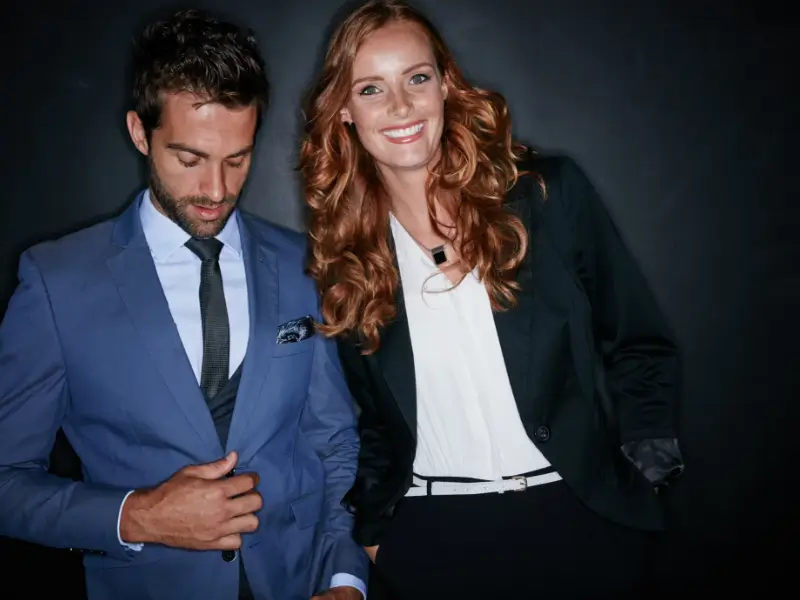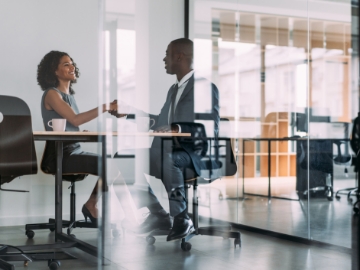What to Wear to an Interview: 2025 Male & Female Outfit Guide

Wearing clothes that are too casual or inappropriate is one of the biggest red flags in a job interview and may affect the first impression you make on potential employers. Your goal as a candidate is to present yourself as professional, polished, and suitable for the company culture.
But what is appropriate to wear to a job interview? Is there anything to avoid? The truth is, there are clear guidelines depending on industry, company culture, and role. This guide breaks down what men and women should wear to look confident, professional, and ready for success.
How important is appearance in a job interview?
Appearance does matter in a job interview. How you present yourself can influence how competent, professional, and suitable you appear for the role. So, it's important to know what to wear to an interview.
A 2022 study found that candidates who "look the part" are more likely to be hired. This suggests that matching the expected image of the role can improve hiring chances. For example, in corporate finance, a well-fitted suit can project professionalism, while in a creative agency, smart-casual with a touch of personality can show both skill and cultural fit.
A survey also supports the importance of appearance in formal interviews. It revealed that 69.6% of decisions by hiring managers are made after the first 5 minutes. This means that what you wear can help you start the interview on a positive note.
Job interview outfit: What to wear to a job interview
Now that you understand the impact of your appearance, here are some guidelines on how to dress for a job interview.
1. Male
Formal environment
For business formal environments, such as law firms, financial institutions, or corporate offices, a formal look is important.
- Suit: Dark, well-fitted, and tailored suit in charcoal, navy, or black.
- Shirt: Long-sleeved dress shirt in white or light blue.
- Tie: Simple silk tie in a solid color or subtle pattern. Avoid bright or novelty ties.
- Shoes: Polished oxfords or loafers in black or brown.
- Socks: Dark socks matching your suit.
- Grooming: Neatly styled hair and clean-shaven or well-trimmed facial hair.
Business casual environment
For a relaxed office, such as a tech startup or non-profit, dress casually but keep it professional.
- Blazer: Neutral-colored blazer or sport coat with slacks or dark, well-fitted jeans.
- Shirt: Button-down or clean, pressed polo.
- Pants: Chinos, slacks, or dark jeans.
- Shoes: Loafers, polished boots, or clean sneakers (no athletic shoes).
- Grooming: Neat, styled hair.
Creative environment
For creative fields like advertising or design, show some personality in your clothing while keeping it professional.
- Jacket: Stylish blazer, leather jacket, or clean bomber.
- Shirt: Button-down, plain t-shirt, or turtleneck.
- Pants: Trousers, chinos, or dark jeans.
- Shoes: Dress boots, loafers, or stylish sneakers.
- Accessories: Add a watch, pocket square, or belt to show personality.
2. Female
Formal environment
Women in conservative industries should dress to show professionalism and authority with a polished, serious look.
- Suit: Well-fitted pantsuit or skirt suit in charcoal, navy, or black.
- Blouse/top: Button-down shirt or simple blouse in white, cream, or light blue.
- Skirt: Knee-length skirt (or longer).
- Shoes: Clean, polished closed-toe heels or flats with a low to moderate heel.
- Accessories: Minimal jewelry like a simple necklace, stud earrings, and a watch.
- Grooming: Neatly styled hair and natural makeup.
Business casual environment
In relaxed offices, women can wear business casual attire and remain neat and respectful.
- Blazer: Wear with a nice top and trousers or a professional dress.
- Dress/jumpsuit: Simple, solid color; avoid busy patterns or revealing styles.
- Pants: Customized trousers, chinos, or dark, non-distressed jeans.
- Shoes: Loafers, polished boots, or professional flats.
- Grooming: Keep hair neat and styled; a natural makeup look works best.
Creative environment
For creative roles, you can show your style while keeping a professional look.
- Jacket: Blazer, leather jacket, or trendy jacket.
- Top: Unique blouse, simple top, or knit sweater.
- Pants/skirt: Tailored trousers, stylish skirt, or dark jeans.
- Dress: Modern dress with an interesting cut or subtle pattern.
- Shoes: Flats, boots, or heels.
- Accessories: Add a scarf, statement necklace, or stylish bag to show your style.
Remember that some industries have specific outfits. Electricians or plumbers can wear a clean polo shirt and work pants. In healthcare, wear business casual or clean, pressed scrubs if a uniform is required. Some companies also have a company's dress code, so check before your interview.
What not to wear in an interview
Wearing the appropriate attire can highlight your professionalism and let your qualifications shine. Here are some things to avoid when choosing your interview outfit.
- Casual summer clothes like shorts, tank tops, flip-flops, sandals, or revealing clothing
- Sneakers or athletic shoes; only clean, presentable ones in casual or creative environments
- T-shirts, even under a blazer
- Wrinkled, torn, ill-fitting, or overly casual clothes
- Flashy patterns, neon colors, or distracting designs
- Large or excessive jewelry
- Strong perfume, cologne, or other strong scents
- Uncomfortable or restrictive clothes
- Outfits that don't fit the company's culture or dress code
- Loungewear or sweatpants during virtual interviews
10 tips for dressing for an interview: Interview attire guide
Here are some essential tips on what to wear to an interview and dressing appropriately to present yourself professionally.
Tip #1: Wear blue-colored clothing
A study found that blue is the best color for interviews. Blue signals that you are trustworthy and a team player. Other good options are black (authority), gray (dependability), and white (organization). Avoid orange, brown, busy patterns, and red, which can seem aggressive.
Tip #2: Observe employee styles
Before your interview, check the company's website or social media to see how current employees dress. This gives a sense of the company culture and helps you select an interview outfit that fits in naturally.
Tip #3: Dress slightly above the standard
After knowing the dress code, wear something slightly more formal than usual. This shows professionalism. A blazer, polished shoes, or neat accessories can elevate your job interview outfit without being flashy.
Tip #4: Prioritize fit and comfort
Clothes that do not fit well can be distracting. Choose clothes that fit well and allow easy movement so you can focus on your answers, not your job interview outfit.
Tip #5: Use neutral colors with a subtle twist
Neutral colors such as navy, beige, gray or blackwork well for interviews. Add a small touch of color, such as a tie, scarf, or accessory, to show personality without being distracting.
Tip #6: Keep accessories simple
Choose minimal, professional accessories. Women can wear small earrings, a necklace, or a classic watch. Men can wear a watch, tie, and belt. Avoid flashy or noisy items that distract from the interview.
Tip #7: Hair, grooming, and scent matter
Your appearance matters as much as your clothes. Keep your hair clean and neat, and your nails tidy. Avoid strong perfumes or colognes; use little or none to prevent overpowering the room or causing allergies.
Tip #8: Dress for the role
Think about the role and industry when choosing your job interview outfit. A suit works for corporate jobs, while a neat, casual look may suit creative or startup positions. Your clothing should show that you understand the job's expectations.
Tip #9: Verify the dress code
Confirm the dress code through multiple sources: company website, recruiter, HR, or employees. This makes sure your interview outfit fits the company's expectations.
Tip #10: Pay attention to small details
Make sure your shoes are clean, your clothes are wrinkle-free, and there are no loose threads. These small details show you are careful and take pride in your professional appearance, which prospective employers notice.
Use this guide as a reference for choosing your job interview outfit. Dress professionally to demonstrate your professionalism and respect for the opportunity. Choose the right outfit that reflects your personal style and makes you feel confident. You don't need flashy or expensive items; focus on looking neat and put-together. How you carry yourself in the outfit matters most.



